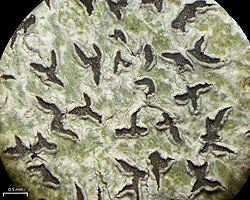Biology:Leiorreuma
| Leiorreuma | |
|---|---|

| |
| Leiorreuma explicans | |
| Scientific classification | |
| Domain: | Eukaryota |
| Kingdom: | Fungi |
| Division: | Ascomycota |
| Class: | Lecanoromycetes |
| Order: | Graphidales |
| Family: | Graphidaceae |
| Genus: | Leiorreuma Eschw. (1824) |
| Type species | |
| Leiorreuma hepaticum Eschw. (1824)
| |
Leiorreuma is a genus of script lichens in the family Graphidaceae. It has 18 species.[1] The genus was circumscribed by Franz Gerhard Eschweiler in 1824, with Leiorreuma hepaticum assigned as the type species.
Description
Leiorreuma is identified by certain features. It has apothecia with noticeable [[Glossary of lichen terms#{{biology:{1}}}|{{Biology:{1}}}]] opened [[Glossary of lichen terms#{{biology:{1}}}|{{Biology:{1}}}]]. The [[Glossary of lichen terms#{{biology:{1}}}|{{Biology:{1}}}]] is often thin on the sides but well-developed at the base and appears [[Glossary of lichen terms#{{biology:{1}}}|charred]]. The hymenium is dotted with small specks, and the spores are pale brown and have thin walls with crosswise septa or are divided into many compartments ([[Glossary of lichen terms#{{biology:{1}}}|{{Biology:{1}}}]]). They are not stained by iodine.[2]
Species
- Leiorreuma convariatum (Kremp.) A.W.Archer (2007)
- Leiorreuma crassimarginatum Z.F.Jia (2015)[2] – China
- Leiorreuma dilatatum (Vain.) Staiger (2002)
- Leiorreuma ellipticum (Müll.Arg.) Staiger (2002)
- Leiorreuma erodens Seavey & J.Seavey (2017)[3] – Florida
- Leiorreuma exaltatum (Mont. & Bosch) Staiger (2002)
- Leiorreuma explicans (Fink) Lendemer (2008)
- Leiorreuma hepaticum Eschw. (1824)
- Leiorreuma hypomelaenoides Poengs. & Kalb (2014)[4] – Thailand
- Leiorreuma hypomelaenum (Müll.Arg.) Staiger (2002)
- Leiorreuma melanostalazans (Leight.) A.W.Archer (2005)
- Leiorreuma nicobarense Pushpi Singh, Jagadeesh and Kr.P.Singh (2017)[5] – India
- Leiorreuma nornotaticum (A.W.Archer & Elix) A.W.Archer (2005)
- Leiorreuma patellulum (Fée) Staiger (2002)
- Leiorreuma sericeum (Eschw.) Staiger (2002)
- Leiorreuma subpatellulum U.Dubey, Upreti & Nayaka (2010)[6] – India
- Leiorreuma taiwanense M.Nakan., Kashiw. & K.H.Moon (2008)[7] – Taiwan
- Leiorreuma vaginans (Zahlbr.) A.W.Archer (2007)
- Leiorreuma vicarians (Vain.) M.Nakan. & Kashiw. (2003)
- Leiorreuma yakushimense (M.Nakan.) M.Nakan. & Kashiw. (2003)[8] – Japan
References
- ↑ Wijayawardene, N.N.; Hyde, K.D.; Dai, D.Q.; Sánchez-García, M.; Goto, B.T.; Saxena, R.K. et al. (2022). "Outline of Fungi and fungus-like taxa – 2021". Mycosphere 13 (1): 53–453. doi:10.5943/mycosphere/13/1/2. https://www.researchgate.net/publication/358798332.
- ↑ 2.0 2.1 Wang, Xiao-Hua; Xu, Li-Li; Jia, Ze-Feng (2015). "The lichen genus Leiorreuma in China". Mycotaxon 130 (1): 247–251. doi:10.5248/130.247.
- ↑ Seavey, F.; Seavey, J.; Gagnon, J.; Guccion, J.; Kaminsky, B.; Pearson, J.; Podaril, A.; Randall, B. (2017). "The lichens of Dagny Johnson Key Largo Hammock Botanical State Park, Key Largo, Florida, USA". Bulletin of the Florida Museum of Natural History 53 (5): 201–268.
- ↑ Poengsungnoen, Vasun; Manoch, Leka; Mongkolsuk, Pachara; Kalb, Klaus (2014). "New species of Graphidaceae from Loei Province, Thailand". Phytotaxa 189 (1): 255. doi:10.11646/phytotaxa.189.1.18.
- ↑ Singh, Pushpi; Ram, T.A.M. Jagadeesh; Singh, K.P. (2017). "A new species of Leiorreuma (Ascomycota, Ostropales) from Great Nicobar Island, India". Bangladesh Journal of Plant Taxonomy 24 (1): 9–12. doi:10.3329/bjpt.v24i1.33000.
- ↑ Dubey, Urvashi; Upreti, Dalip K.; Nayaka, Sanjeeva (2010). "A new species of Leiorreuma Eschw. from India". The Lichenologist 42 (6): 711–713. doi:10.1017/s002428291000040x.
- ↑ Moon, Kwang Hee; Nakanishi, Minoru; Kashiwadani, Hiroyuki (2008). "Notes on species of Graphidaceae (Ascomycotina) from eastern Asia with three new species". Bulletin of the National Museum of Nature and Science, Series B (Botany), Tokyo 45: 85–91. https://www.kahaku.go.jp/research/publication/memoir/download/45/4508.pdf.
- ↑ Kashiwadani, Hiroyuki; Nakanishi, Minoru; Miyawaki, Hiromi; Takeshita, Shunji; Ohmura, Yoshihito; Tokizawa, Mika; Moon, Kwang Hee (2012). "Materials for the distribution of Lichens in Japan (19). Leiorreuma yakushimense (M. Nakan.) M. Nakan. & Kashiw. and Siphula decumbens Nyl.". Journal of Japanese Botany 87 (6): 408–411.
Wikidata ☰ Q10556555 entry
 |

